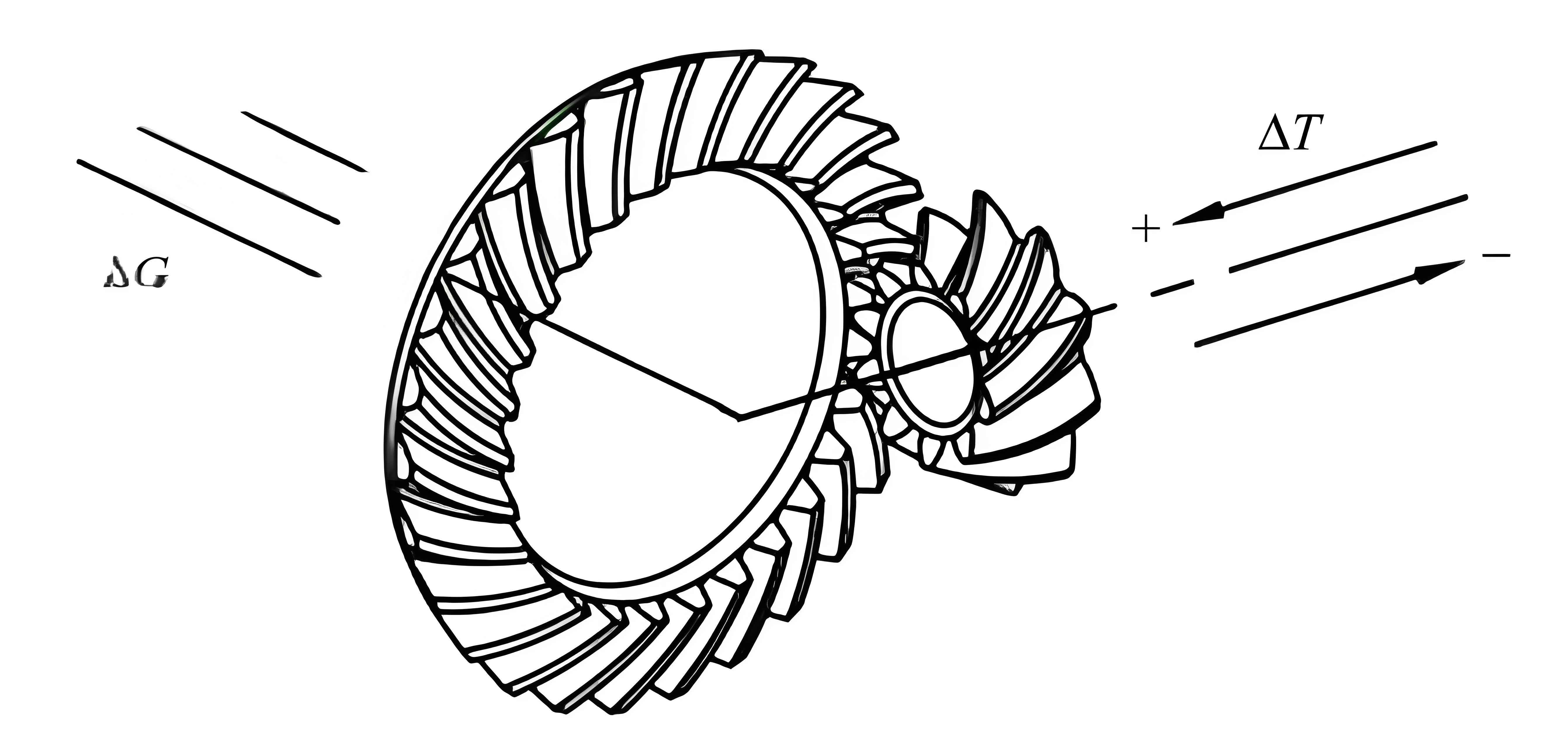Abstract
Accurate analysis of meshing misalignment in spiral bevel gear transmission systems under load is critical for optimizing gear tooth profiles. Traditional beam element models often fail to capture complex shaft deformations, leading to significant errors in misalignment prediction. To address this, we propose a stepwise meshing misalignment analysis method based on the solid finite element (FE) approach. This method involves: (1) constructing a solid FE model of the transmission shaft coupled with bearing stiffness, (2) applying equivalent gear meshing forces to analyze shaft deformation, (3) calculating meshing misalignment using deformation results, and (4) performing loaded tooth contact analysis (LTCA) to evaluate contact patterns and transmission errors. Validation against a full FE model demonstrates that our method achieves high accuracy (errors <2.5%) while reducing computational time by 76.7%.

1. Introduction
Spiral bevel gear is widely used in automotive, aerospace, and marine applications due to their high load-carrying capacity and smooth operation. However, under load, shaft deformation induces misalignment between gear pairs, degrading transmission performance. Traditional approaches simplify shafts as beam elements, which introduce errors for complex geometries. This paper presents a robust methodology to analyze meshing misalignment in spiral bevel gear systems using solid FE models, balancing accuracy and computational efficiency.
2. Definition and Calculation of Meshing Misalignment
2.1 Meshing Misalignment Parameters
Meshing misalignment arises from relative displacements and angular deviations between gear axes under load. Key parameters include:
- Axial displacement (ΔP): Relative displacement along the pinion axis.
- Offset displacement (ΔE): Radial shift perpendicular to the gear plane.
- Angular deviation (ΔΣ): Change in the shaft intersection angle.
The misalignment vector R′R′ is defined as:R′=ROA−ROBR′=ROA−ROB
where ROAROA and ROBROB are displacement vectors of the shaft intersection points (Figure 1). Projecting R′R′ onto the initial coordinate system yields:{ΔP=(R′−ROQ)⋅iΔE=(R′−ROQ)⋅kΔΣ=θ2−θ1⎩⎨⎧ΔP=(R′−ROQ)⋅iΔE=(R′−ROQ)⋅kΔΣ=θ2−θ1
Here, θ1θ1 and θ2θ2 are the initial and deformed shaft angles.
2.2 Deformation Analysis
Shaft deformation is calculated using FE models. For a beam element model, the global stiffness matrix KinKin is assembled from segmental stiffness matrices:Kin=∑i=1n−1Ki(i+1)Kin=i=1∑n−1Ki(i+1)
where Ki(i+1)Ki(i+1) is the stiffness matrix of the ii-th segment. Force-deformation relationships follow:F=Kin⋅δF=Kin⋅δ
However, beam models exhibit significant errors compared to solid FE models (Table 1).
Table 1: Shaft Deformation Comparison (Beam vs. Solid FE Model)
| Node | Beam Model Deformation (mm) | Solid FE Model Deformation (mm) | Error (%) |
|---|---|---|---|
| 5 | X=1.596,Y=1.428,Z=3.804X=1.596,Y=1.428,Z=3.804 | X=1.765,Y=1.543,Z=4.983X=1.765,Y=1.543,Z=4.983 | 13–30 |
| 7 | X=1.590,Y=1.406,Z=3.804X=1.590,Y=1.406,Z=3.804 | X=1.785,Y=1.540,Z=4.983X=1.785,Y=1.540,Z=4.983 | 15–31 |
3. Stepwise Meshing Misalignment Analysis
3.1 Solid FE Shaft Model with Bearing Coupling
The shaft is discretized into hexahedral elements, with bearing stiffness modeled as springs at key nodes (Figure 2). Each bearing node is constrained by five springs (stiffness values derived from bearing specifications):kx,ky,kz,kθx,kθy=f(bearing stiffness matrix)kx,ky,kz,kθx,kθy=f(bearing stiffness matrix)
3.2 Equivalent Meshing Force Calculation
Gear meshing forces are simplified to three components: tangential (FtFt), axial (FaFa), and radial (FrFr). For a spiral bevel gear pair, these forces are:{Ft=TrmFa=FttanβsinαFr=Fttanβcosα⎩⎨⎧Ft=rmTFa=FttanβsinαFr=Fttanβcosα
where TT is torque, rmrm is mean radius, ββ is spiral angle, and αα is pressure angle.
3.3 Loaded Tooth Contact Analysis (LTCA)
Using misalignment parameters (ΔP,ΔE,ΔΣΔP,ΔE,ΔΣ), gear positions are adjusted to build the LTCA model (Figure 3). Contact stresses and transmission errors are evaluated via static FE analysis.
4. Case Study: Automotive Drive Axle
4.1 Gear Parameters and Loads
A spiral bevel gear pair with the following specifications is analyzed:
Table 2: Spiral Bevel Gear Parameters
| Parameter | Pinion | Gear |
|---|---|---|
| Teeth | 7 | 43 |
| Module (mm) | 10.512 | — |
| Pressure Angle (°) | 22.5 | — |
| Spiral Angle (°) | 48.083 | 34.345 |
Applied torque: 15,000 N·m. Calculated meshing forces:
Table 3: Meshing Forces and Moments
| Shaft | FtFt (N) | FaFa (N) | FrFr (N) | Moment (N·m) |
|---|---|---|---|---|
| Input | 81,310 | 28,990 | 62,530 | 2,383 |
| Output | 91,750 | 28,990 | 45,870 | 5,460 |
4.2 Misalignment and Performance Comparison
Table 4: Meshing Misalignment Results
| Parameter | Stepwise Model | Full FE Model | Error (%) |
|---|---|---|---|
| ΔPΔP (mm) | 0.0938 | 0.0952 | 1.5 |
| ΔEΔE (mm) | -0.152 | -0.156 | 2.6 |
| ΔΣΔΣ (°) | 0.0331 | 0.0337 | 1.8 |
The stepwise model’s contact pattern and transmission error (Figure 4) align closely with the full FE model, with a 1.3% deviation in error amplitude. Computational efficiency improved by 76.7% (Table 5).
Table 5: Computational Time Comparison
| Model | Mesh Count | Time (h) |
|---|---|---|
| Stepwise | 989,000 | 6.1 |
| Full FE | 3,080,000 | 26.2 |
5. Conclusion
- Beam element models underestimate shaft deformations by 10–30%, leading to inaccurate spiral bevel gear misalignment predictions.
- The proposed solid FE-based stepwise method achieves <2.5% error in misalignment analysis while reducing computational effort by 76.7%.
- Loaded contact analysis confirms that the method accurately predicts contact patterns and transmission errors, enabling efficient gear design optimization.
This methodology provides a reliable framework for analyzing spiral bevel gear systems, particularly in applications requiring high precision and computational efficiency.
